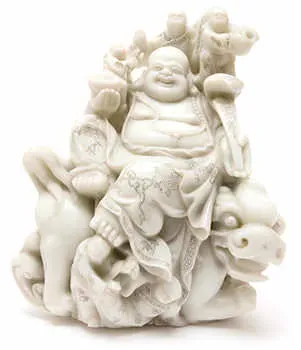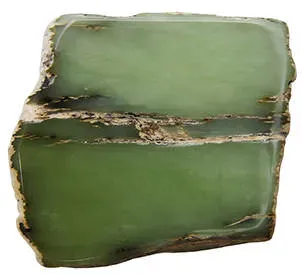 Nephrite is a type of
Nephrite is a type of ![]() jade that was first used for weapons, and later for ornaments. Nephrite is referred to as the old and true Chinese jade. Nephrite and Jadeite are both recognized as jade, and they both have similar properties and appearances, but nephrite is more common, and therefore, the less expensive of the two. For centuries, jadeite and nephrite were considered the same. They were not identified as different until 1863. The two stones actually differ in color and hardness. Jadeite is harder, rating a 7 on the hardness scale, while Nephrite rates only a 6.5. Jadeite comes in virtually every color while Nephrite has a more limited range of color. Any Chinese carving that is more than 230 years old is made from nephrite, as jadeite was unknown to the Chinese before 1740. In ancient China, nephrite was known as the Yu stone, or the Stone of Heaven. In archaic burial sites, it was common to bury a person with six specific nephrite jade figures, to ensure his passage to Heaven. Nephrite jade was excavated from the Kunlun Mountains of northwest China, from 5000 BC to the 1700's, and China remains an important source for the mineral today.
jade that was first used for weapons, and later for ornaments. Nephrite is referred to as the old and true Chinese jade. Nephrite and Jadeite are both recognized as jade, and they both have similar properties and appearances, but nephrite is more common, and therefore, the less expensive of the two. For centuries, jadeite and nephrite were considered the same. They were not identified as different until 1863. The two stones actually differ in color and hardness. Jadeite is harder, rating a 7 on the hardness scale, while Nephrite rates only a 6.5. Jadeite comes in virtually every color while Nephrite has a more limited range of color. Any Chinese carving that is more than 230 years old is made from nephrite, as jadeite was unknown to the Chinese before 1740. In ancient China, nephrite was known as the Yu stone, or the Stone of Heaven. In archaic burial sites, it was common to bury a person with six specific nephrite jade figures, to ensure his passage to Heaven. Nephrite jade was excavated from the Kunlun Mountains of northwest China, from 5000 BC to the 1700's, and China remains an important source for the mineral today.
 Nephrite also plays a role in Russian history as well. Since 3000 BC, it has been mined and crafted there. In fact, Czar Alexander III's sarcophagus was carved out of nephrite. The native North Americans of British Columbia, Canada, also prize the stone. It has been prized there for about 3000 years and used to be referred to as squa or lisht. Some of the best quality nephrite is found in New Zealand, where the stone is known as greenstone. For centuries, the Maori people there have made beautiful nephrite carvings, and they relied on the stone for tools until the Europeans introduced metals in the 18th century. The Maori used to carve nephrite into images of ancestral figures, which were usually set with mother-of-pearl eyes. These pieces were called hei tiki and were worn on ceremonial occasions.
Nephrite also plays a role in Russian history as well. Since 3000 BC, it has been mined and crafted there. In fact, Czar Alexander III's sarcophagus was carved out of nephrite. The native North Americans of British Columbia, Canada, also prize the stone. It has been prized there for about 3000 years and used to be referred to as squa or lisht. Some of the best quality nephrite is found in New Zealand, where the stone is known as greenstone. For centuries, the Maori people there have made beautiful nephrite carvings, and they relied on the stone for tools until the Europeans introduced metals in the 18th century. The Maori used to carve nephrite into images of ancestral figures, which were usually set with mother-of-pearl eyes. These pieces were called hei tiki and were worn on ceremonial occasions.
 Nephrite is a form of amphibole, which is a type of rock-forming silicate that is widely distributed in igneous and metamorphic rocks. Amphiboles are typically fibrous, which explains nephrite's durability. Nephrite's fibrous crystals interlock, making it even stronger than steel, and the toughest of all natural stones. In fact, nephrite is so strong that it cannot be chiseled, but has to be ground using sharp abrasives. This is why, in antiquity, nephrite was so often used in weaponry. Nephrite varies in color from white to yellow to green and brown or black. The more magnesium a specimen is composed of, the lighter the color will be. Usually, nephrite is found in dark green colors, such as a sage or spinach color. Stones may be homogeneous in color or blotchy or banded. Nephrite is more translucent than jadeite, so it is used more often for delicately carved jewelry, such as cameos.
Nephrite is a form of amphibole, which is a type of rock-forming silicate that is widely distributed in igneous and metamorphic rocks. Amphiboles are typically fibrous, which explains nephrite's durability. Nephrite's fibrous crystals interlock, making it even stronger than steel, and the toughest of all natural stones. In fact, nephrite is so strong that it cannot be chiseled, but has to be ground using sharp abrasives. This is why, in antiquity, nephrite was so often used in weaponry. Nephrite varies in color from white to yellow to green and brown or black. The more magnesium a specimen is composed of, the lighter the color will be. Usually, nephrite is found in dark green colors, such as a sage or spinach color. Stones may be homogeneous in color or blotchy or banded. Nephrite is more translucent than jadeite, so it is used more often for delicately carved jewelry, such as cameos.
 In the late 19th century, Chinese miners in California discovered large boulders of nephrite
In the late 19th century, Chinese miners in California discovered large boulders of nephrite ![]() jade that they sent back to China to be cut or carved. Other American localities of nephrite include Wyoming and Alaska. In Siberia, dark green nephrite rocks with black spots are often found, and in Russia and China, the nephrite is spinach colored. Nephrite is also found in various rocks in the north and south islands of New Zealand. Pieces carved there in the 17th century are called meres- these were Maori clubs. Other localities for nephrite include Australia, Canada, Mexico, Brazil, Taiwan, Zimbabwe, Italy, Poland, Germany, and Switzerland.
jade that they sent back to China to be cut or carved. Other American localities of nephrite include Wyoming and Alaska. In Siberia, dark green nephrite rocks with black spots are often found, and in Russia and China, the nephrite is spinach colored. Nephrite is also found in various rocks in the north and south islands of New Zealand. Pieces carved there in the 17th century are called meres- these were Maori clubs. Other localities for nephrite include Australia, Canada, Mexico, Brazil, Taiwan, Zimbabwe, Italy, Poland, Germany, and Switzerland.